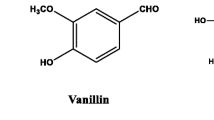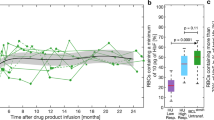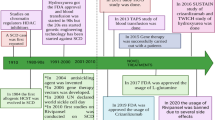Abstract
The most studied pharmacological intervention in sickle cell anemia aiming at elevating HbF expression is the use of hydroxyurea. At the present time the experience has been that after 1 year of treatment with maximum tolerated doses (MTD) all patients showed increases of percent HbF, with a mean of 15% HbF, without apparent side effects besides the reversible ones observed during the process of attaining the MTD. The question of efficacy is presently being investigated by a multicenter placebo controlled double blind clinical trial that involves more than 20 sites. The goal of the study is to determine if hydroxyurea can decrease the incidence of painful crises by 50%. Results of this study are not expected before the end of 1993.
Similar content being viewed by others
Literature
Al-Awamy, B., Wilson, W. A., and Pearson, H. A., Splenic function in Saudi children with sickle cell disease in the Eastern Province of Saudi Arabia. J. Pediatr.104 (1984) 714–717.
Allison, A. C., Properties of sickle-cell haemoglobin. Biochem. J.65 (1957) 212–219.
Alter, B. P., and Gilbert, H. S., The effect of hydroxyurea on hemoglobin F in patients with myeloproliferative syndromes. Blood66 (1985) 373–379.
Bertles, J. F., Rabinowitz, R., and Dobler, J., Hemoglobin interaction: Modification of solid phase composition in the sickling phenomenon. Science169 (1970) 375–377.
Boyer, S. H., Belding, T. K., Margolet, L., and Noyes, A. N., Fetal hemoglobin restriction to a few erythrocytes (F cells) in normal human adults. Nature188 (1975) 361–363.
Charache, S., Treatment of sickle cell anemia. A. Rev. Med.32 (1981) 195–206.
Charache, S., Dover, G. J., Moore, R. D., Eckert, S., Ballas, S. K., Koshy, M., Milner, P. F., Orringer, E. P., Phillips, G., Platt, O. S., and Thomas, G. H., Hydroxyurea: effects on hemoglobin F production in patients with sickle cell anemia. Blood79 (1992) 2555–2565.
Charache, S., Dover, G. J., Moyer, M. A., and Moore, J. W., Hydroxyurea-induced augmentation of fetal hemoglobin production in patients with sickle cell anemia. Blood69 (1987) 109–116.
Charache, S., Dover, G. J., Smith, K. D., and Talbot, C. C., Treatment of sickle cell anemia with 5-azacytidine results in increased fetal hemoglobin production and is associated with non-randorn hypomethylation of DNA around the—globin gene complex. Proc. natl Acad. Sci. USA80 (1983) 4842–4846.
Conley, C. L., Weatherall, D. J., Richardson, S. N., Shepard, M. K., and Charache, S., Hereditary persistence of fetal hemoglobin: a study of 79 affected persons in 15 Negro families in Baltimore. Blood21 (1963) 261–281.
DePass, L. R., and Weaver, E. V., Comparison of teratogenic effects of aspirin and hyroxyurea in the Fischer 344 and Wistar strains. J. Toxic. envir. Health10 (1982) 297–305.
De Simone, J., Schimenti, J. C., Duncan, C. H., Heller, P., and Lavelle, D., DNA methylation and expression of baboon globin genes, in: The Red Cell: Sixth Ann Arbor Conference, pp. 59–72. Alan R. Liss, Inc., New York 1983.
Dover, G. J., Boyer, S. H., Charache, S., and Heintzelman, K., Individual variation in the production and survival of F cells in sickle-cell disease. New Engl. J. Med.299 (1978) 1428–1435.
Dover, G. J., and Charache, S., Increasing fetal hemoglobin production in sickle cell disease: Results of clinical trials, in: Developmental Control of Globin Gene Expression, pp. 455–466. Ed. G. Stamatoyannopoulos. Alan R. Liss, New York 1987.
Dover, G. J., Charache, S., and Boyer, S. H., 5-Azacytidine increases fetal hemoglobin production in a patient with sickle cell disease, in: Globin Gene Expression and Hematopoietic Differentiation, pp. 475–488. Eds G. Stamatoyannopoulos and A. W. Nienhuis. Alan R. Liss, New York 1983.
Dover, G. J., Charache, S., Nora, R., and Boyer, S. H., Progress toward increasing fetal hemoglobin production in man: Experience with 5-azacytidine and hydroxyurea. Ann. N. Y. Acad. Sci.45 (1985) 218–224.
Dover, G. J., Humphries, R. K., and Ley, T. J., Increases in fetal hemoglobin using cell-cycle specific agents: Lessons from in vitro culture systems, in: Regulation of Erythropoiesis. Eds E. D. Zanjani, M. Tavassoli and J. L. Ascensao. PMA Publishing, New York 1988.
Dover, G. J., Humphries, R. K., Moore, J. G., Ley, N. S., Young, S., Charache, S., and Nienhuis, A. W., Hydroxyurea induction of hemoglobin F production in sickle cell disease: Relationship between cytotoxicity and F cell production. Blood67 (1986) 735–738.
Dover, G. J., Humphries, R. K., Young, N. S., Ley, T., Boyer, S., Charache, S., and Nienhuis, A., Pharmacologic manipulation of fetal hemoglobin synthesis, in: Experimental Approaches for the Study of Hemoglobin Switching, pp. 447–454. Eds G. Stamatoyannopoulos and A. W. Nienhuis. Alan R. Liss, New York 1985.
Edington, G. M., and Lehmann, H., Expression of the sickle-cell gene in Africa. Br. Med. J.1 (1955) 1308–1311;2 (1955) 1328.
Fruchtman, S. M., 1989 personal communication.
Gebhart, E., Sister chromatid exchange (SCE) and structural chromosome aberration in mutagenicity testing. Hum. Genet.58 (1981) 235–254.
Greenberg, M. S., Kass, E. H., and Castle, W. B., Studies on the destruction of red blood cells: XII. Factors influencing the role of S hemoglobin in the pathologic physiology of sickle cell anemia and related disorders. J. clin. Invest.36 (1957) 833–843.
Hofrichter, J., Ross, P. D., and Eaton, W. A., Kinetic and mechanism of deoxyhemoglobin S gelation: A new approach to understanding sickle cell disease. Proc. natl Acad. Sci. USA71 (1974) 4864–4868.
Jackson, J. F., Odom, J. L., and Bell, W. N., Amelioration of sickle cell disease by persistent fetal hemoglobin. J. Am. med. Assoc.177 (1961) 867–869.
Jacob, G. F., and Raper, A. B., Hereditary persistence of foetal haemoglobin production, and its interaction with the sickle-cell trait. Br. J. Haemat.4 (1958) 138–149.
Kar, B. C., Satapathy, R. K., Kulozik, A. E., Kulozik, M., Stirr, S., Serjeant, B. E., and Serjeant, G. R., Sickle cell disease in Orissa State, India. Lancet2 (1986) 1198–1201.
Letvin, N. L., Linch, D. C., Beardsley, P., McIntyre, K. W., and Nathan, D. G., Augmentation of fetal-hemoglobin production in anemic monkeys by hydroxyurea. N. Engl. J. Med.310 (1984) 869–873.
Letvin, N. L., Linch, D. C., Beardsley, P., McIntyre, K. W., Miller, B. A., and Nathan, G., Influence of cell cycle phase-specific agents on simian fetal hemoglobin synthesis. J. clin. Invest.75 (1985) 1999–2005.
Ley, T. J., De Simone, J., Anagnou, N. P., Keller, G. H., Humphries, R. K., Turner, P. A., Young, N. S., Heller, P., and Nienhuis, A. W., 5-Azacytidine selectively increases gamma-globin synthesis in a patient with beta-plus thalassemia. N. Engl. J. Med.307 (1982) 1469–1475.
Mavilio, F., Giampaolo, A., Care, A., Migliaccio, G., Calandrini, M., Russo, G., Pagliardi, G. L., Mastroberardino, G., Marinucci, M., and Peschle, C., Molecular mechanisms of human hemoglobin switching: Selective undermethylation and expression of globin genes in embryonic, fetal, and adult erythroblasts. Proc. natl Acad. Sci. USA80 (1983) 6907–6911.
Messer, M. J., and Harris, J. W., Filtration characteristics of sickle cells: Rates of alteration of filterability after deoxygenation and reoxygenation, and correlations with sickling and unsickling. J. Lab. clin. Med.76 (1970) 537–547.
Mozzarelli, A., Hofrichter, J., and Eaton, W. A., Delay time of hemoglobin S polymerization prevents most cells from sickling in vivo. Science237 (1987) 500–506.
Muranyi-Kovasc, I., and Rudali, G., Comparative study of carcinogenic activity of hydroxyurea and urethane in XVII/G mice. Rev. Eur. Etud. clin. Biol.17 (1972) 93–95.
Nagel, R. L., Bookchin, R. M., Johnson, J., Labic, D., Wajcman, H., Isaac-Sodeye, W. A., Honig, G. R., Schiliro, G., Crookston, J. H., and Matsutomo, K., Structural bases of the inhibitory effects of hemoglobin F and hemoglobin A2 on the polymerization of hemoglobin S. Proc. natl Acad. Sci. USA76 (1979) 670–672.
Noguchi, C. T., Torchia, D. A., and Schechter, A. N.,13C NMR quantitation of polymer in deoxyhemoglobin S gels. Proc. natl Acad. Sci. USA76 (1979) 4936–4940.
Papayannopoulou, T., Torrealba-de Ron, A., Veith, R., Knitter, G., and Stamatoyannopoulos, G., Arabinosylcytosine induces fetal hemoglobin in baboons by perturbing crythroid cell differentiation kinetics. Science224 (1984) 617–618.
Pembrey, M. E., Wood, W. G., Weatherall, D. J., and Perrine, R. P., Fetal haemoglobin production and the sickle cell gene in the oases of eastern Saudi Arabia. Br. J. Haemat.40 (1978) 415–429.
Perrine, R. P., Brown, M. J., Clegg, J. B., Weatherall, D. J., and May, A., Benign sickle cell anaemia. Lancet2 (1972) 1163–1167.
Perrine, R. P., Pembrey, M. E., John, P., Perrine, S., and Shoup, F., Natural history of sickle cell anemia in Saudi arabs. A study of 270 subjects. Ann. int. Med.88 (1978) 1–6.
Platt, O. S., Thorington, B. D., Brambilla, D. J., Milner, P. F., Rosse, W. F., Vichinsky, E., and Kinney, T. R., Pain in sickle cell disease: rates and risk factors. N. Engl. J. Med. (1991) 11–16.
Powars, D. R., Weiss, J. N., Chan, L. S., and Schroeder, W. A., Is there a threshold level of fetal hemoglobin that ameliorates morbidity in cell anemia? Blood63 (1984) 921–926.
Razin, A., and Riggs, A. D., DNA methylation and gene function. Science210 (1980) 604–610.
Russell, M. O., Goldberg, H. I., Hodson, A., Kim, H. C., Halus, J., Reivich, M. and Schwartz, E., Effect of transfusion therapy on arteriographic abnormalities and on recurrence of stroke in sickle cell disease. Blood63 (1984) 162–169.
Scott, R., Hydroxyurea teratogenesis and mutagenesis. Devl Biol.26 (1971) 306–315.
Serjeant, G. R., Serjeant, B. E., Desai, P., Mason, K. P., Sewell, A., and England, J. M., The determinants of irreversibly sickled cells in homozygous sickle cell disease. Br. J. Haemat.40 (1978) 431–438.
Shepard, M. K., Weatherall, D. J., and Conley, C. L., Semi-quantitative estimation of the distribution of fetal hemoglobin in red cell populations. Bull. Johns Hopkins Hosp.110 (1962) 293–310.
Singer, K., and Fisher, B., Studies on abnormal hemoglobins: V. The distribution of type S (sickle cell) and type F (alkali resistant) hemoglobin with the red cell population in sickle cell anemia. Blood7 (1952) 1216–1226.
Singer, K., and Singer, L., Studies on abnormal hemoglobins. VIII. The gelling phenomenon of sickle-cell hemoglobin: its biologic and diagnostic significance. Blood8 (1953) 1008–1023.
Soukup, S., Takacs, E., and Warkany, J., Chromosome changes in embryos treated with various teratogens. J. Embryol. exp. Morphol.18 (1967) 215–226.
Steinberg, M. H., Dreiling, B. J., Morrison, F. S., and Necheles, T. F., Mild sickle cell disease. Clinical and laboratory studies. J. Am. med. Assoc.224 (1973) 317–321.
Steinberg, M. H., and Hebbel, R. P., Clinical diversity of sickle cell anemia: genetic and cellular modulation of disease severity. Am. J. Hemat.14 (1983) 405–416.
Timson, J., Hydroxyurea. Mutat. Res.32 (1975) 115–132.
Tuan, D., Murnane, M. J., deRiel, J. K., and Forget, B. G., Heterogeneity in the molecular basis of hereditary persistence of fetal haemoglobin. Nature28 (1980) 335–337.
van der Ploeg, L. H. T., and Flavell, R. A., DNA methylation in the human gamma-delta-beta-globin locus in erythroid and nonerythroid tissues. Cell19 (1980) 947–958.
Veith, R., Galanello, R., Papayannopoulou, T., and Stamatoyannopoulos, G., Stimulation of F-cell production in patients with sickle-cell anemia treated with cytarabine or hydroxyurea. N. Engl. J. Med.310 (1984) 869–873.
Veith, R., Papayannopoulou, T., Kurachi, S., and Stamatoyannoupoulos, G., Treatment of baboon with vinblastine: Insights into the mechanisms of pharmacologic stimulation of HbF in the adult. Blood66 (1985) 456–459.
Watson, J., The significance of the paucity of sickle cells in newborn Negro infants. Am. J. med. Sci.215 (1948) 419–423.
Went, L. N., and MacIver, J. E., An unusual type of hemaglobinopathy resembling sickle cell-thalassemia disease in a Jamaican family. Blood13 (1958) 559–568.
Wishner, B. C., Ward, K. B., Lattman, E. E., and Love, W. E., Crystal structure of sickle-cell deoxyhemoglobin at 5 A resolution. J. molec. Biol.98 (1975) 179–194.
Wyrobek, A. J., and Bruce, W. R., Chemical induction of sperm abnormalities in mice. Proc. natl Acad. Sci. USA72 (1975) 4425–4429.
Zarkowsky, H. S., and Hochmuth, R. M., Sickling times of individual erythrocytes at zero PO2. J. clin. Invest.56 (1975) 1023–1034.
Author information
Authors and Affiliations
Rights and permissions
About this article
Cite this article
Charache, S. Pharmacological modification of hemoglobin F expression in sickle cell anemia: An update on hydroxyurea studies. Experientia 49, 126–132 (1993). https://doi.org/10.1007/BF01989416
Issue Date:
DOI: https://doi.org/10.1007/BF01989416




